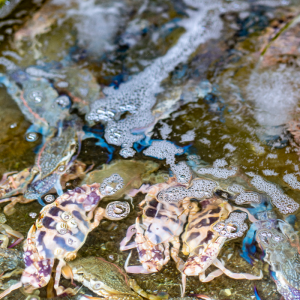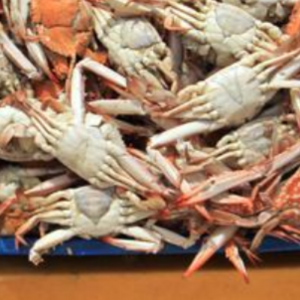
Crab Seed Production Techniques
| Thu, 26 Sep 2019 - 16:53
Crabs are one of the aquatic species with high nutritional and economic value. The successful production of artificial crabs contributes to the development of mud crab farming models in many localities throughout the country.
Water treatment
The water used has a salinity of 25 ‰ or more. After filling the sedimentation tank with water, apply potassium permanganate (KMnO4), concentration of 1.5 - 2 ppm (1.5 - 2 g / m3). Aeration of sedimentation tanks continuously for 30 minutes, followed by using CaCO3 powder (or Dolomite lime) with concentration of 50 g / m3 of water, continue to aerate vigorously for another 30 minutes. Then turn off the aeration to let the water settle all suspended organic matter. Whenever you see the clear water, pump to another tank through a filter bag to treat Chlorine.
Raising parents clap
Preparing the tank: The mother rearing tank is usually a cement tank, a sand compartment occupies 1/3 of the bottom of the tank, the thickness of the sand layer is about 5-7 cm, the remaining space is arranged with facing tiles. sheltered crabs. Feed water has a salinity of 30-32 vỗ. In tanks fitted with moderate aeration.
Choose mother crabs: Choose the females weighing 450 - 600 g, fully legged, clean and full of bricks, preferably crabs from the sea (crabs caught by the rakes). Stocking crabs with a density of 2 fish / m2.
Care: Feed the mother 2 breakfast and afternoon. Feed for crabs is paraplegia, nugget, oysters or blood cockle.
Regularly check and remove uneaten food and waste siphons from the tank.
Change the water for the mother tank every 2 days, completely changing 100%. Each time change the water catch the mother out of the tank, scrub and bathe with iodine (about 7 drops in a bucket containing 20 liters of salt water) for about 5 minutes and then transfer the crab to the new water tank.
The period of raising is about 15 - 20 days, the mother lay eggs.
Incubate and hatch
Hatching eggs: When the mother lays eggs, take them out and incubate in the incubator. Replace the whole water for crabs everyday. Iodine bath with Iodine, concentration of 15 ppm for 1 minute before releasing. Incubation period is about 10-12 days, the crabs hatch depending on the water temperature high or low.
For hatching: When there are a few zoea larvae in the hatching box (usually on the 10th day), the mother will be transferred to hatching tank. Ordinary hatching tanks are plastic or composite tanks with a volume of about 200 - 500 liters, the water supplied to the hatching is similar to the water supplied to the nursery tanks, moderate aeration layout to ensure adequate oxygen but not too strong affecting the ovaries of the mother.
Nursery rearing larvae
Larval rearing tanks can be composite tanks or cement tanks. 1 day before the mother hatched, supply water to nursery tanks, install aeration and treat chemicals. When water is finished, aeration is installed, using EDTA 5 ppm to precipitate all heavy metals in 30 minutes.
The feed for zoea 1 larvae is a synthetic feed and Artemia sprung umbrellas, feeding 1 hour after hatching.
When hatching eggs must be removed immediately by the mother to minimize contamination by feces and egg silk of the mother discharged. Reduce the aeration for all the dirt to settle to the bottom of the tank, and use a small stick to remove all the floating egg membranes on the face, then clear all the dirt.
Conducting larvae collection with fine racket, bathing through seawater mixed with iodine and then put into the rearing tank. Stocking density of larvae in rearing tanks: 150 individuals / liter.
Larvae stage 1: Feeding Artemia larvae even though the 7th day. Feeding 4 times a day: 6h, 12h, 18h, 0h.
Normally by the 5th day, the siphon changes water, if it is too dirty, siphon can be changed on the 3rd day. The level of changing the water is not more than 30%.
Larvae stage 2: When there are zoea 5 larvae in the nursery tank, the leveling of new tanks is conducted. The amount of food remains the same, while adding synthetic foods depending on the ability of crab larvae to catch prey.
When larvae transition to megalops stage, stop feeding Artemia, switch to processed / synthetic feed. Feeding 6-8 times a day, the amount of feed depends on the ability to catch the larvae. When the megalops move to the bottom, they need to spread mussel shells in the nursery tank to give them shelter to avoid the phenomenon of eating each other when molting. A few days later continue to attach plastic objects to the tank.
Around 26 - 28 days, the crabs can be collected and exported.
Source : http://www.thuysanvietnam.com.vn






















